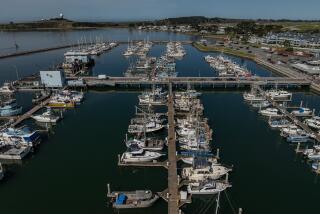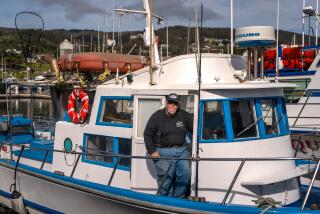A more direct route from fisherman to cook
- Share via
As expensive as wild salmon is at the grocery, most fishermen who catch it barely make enough money to get by. But that may be changing, thanks to an unusual group of marketing coalitions between fishermen and ecological and tribal groups.
Inspired by the success of the Copper River Salmon Producers Assn. at turning its fish into a hot commodity, the groups aim to increase the fishermen’s take by more directly connecting them with cooks.
One such effort is led by Amy Grondin, a direct marketing consultant who works for the Pacific Marine Conservation Council, a nonprofit ecological group based in Seattle. Grondin works to match up troll fishermen with chefs and high-end retail outlets.
“Our mission is to keep fishing communities viable and keep healthy oceans at the same time,” she says. Grondin, who in addition to her marketing background has worked as a chef and trolls for salmon in the summer, says this kind of innovative direct marketing is essential.
Normally, she says, fishermen only earn a small fraction of their catch’s retail price: “In the traditional chain of distribution, the consumer might be the seventh person to get the fish. Fishermen will catch the fish, then sell it to a buyer-processor, who might in turn sell it to a broker-trader, who will then sell it to a distributor, who will then sell it to the restaurant or market that will finally sell it to the consumer.”
With every step in that chain tacking on a profit, what started out at pennies a pound ends up costing much more. “In Alaska last year, I saw beautiful chinook salmon going for 53 cents a pound to the fishermen that wound up selling for $14.75 a pound at a supermarket in Seattle,” she says.
Not only can direct marketing help the fishermen economically, but it can also help the consumer culinarily. “We call it the chain of custody,” Grondin says. “Every time the fish changes hands it adds more time away from the water. When you have seven steps between the fisherman and the consumer, it’s pretty inconceivable the fish will be fresher than the fifth day by the time the consumer gets it.”
The fish in Grondin’s projects rarely leave the Northwest, but one of her success stories is fisherman Rick Oltman’s Cape Cleare salmon, troll-caught Alaskan kings and cohos that are processed and frozen at sea and then sold directly to consumers on the website www.capecleare.com.
Similarly, a group of native Alaskans in the Aleutian Islands is beginning to market its sockeye salmon under the brand name Aleutia. Now entering its third year, the group is enjoying an exponential rise in sales, climbing from 13,000 pounds in the first year to 100,000 last year by selling direct to high-end restaurants and retail shops including, last summer, Whole Foods. This summer it hopes to double that.
“Our families are primarily Aleut native families who have been harvesting salmon since the second ice age,” says Karen Montoya, who helps promote the effort in her job as the public information officer for the Aleutians East Borough. “It’s something they depend on for their economy, but it’s also a part of who they are.”
It may take time for these groups to be successful, says Brad Warren, editor and associate publisher of industry digest Pacific Fishing, but the chances are good.
“It took a long time for Copper River to get launched,” he says. “It is an extraordinary fish, and the community in Cordova [Alaska] has been marketing it for a century. It took them until only recently to develop enough momentum. But things happen faster today, and I don’t think we’re looking at another century-long ramp-up.”
*
-- Russ Parsons
More to Read
Sign up for The Wild
We’ll help you find the best places to hike, bike and run, as well as the perfect silent spots for meditation and yoga.
You may occasionally receive promotional content from the Los Angeles Times.







